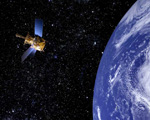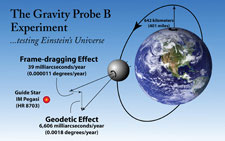WEEKLY UPDATE FOR 4 MARCH 2005:
GRAVITY PROBE B MISSION STATUS AT A GLANCE
| Item | Current Status |
| Mission Elapsed Time | 318 days (45 weeks/10.5 months) |
| Science Data Collection | 189 days (27 weeks/6.25 months) |
| Current Orbit # | 4,694 as of 2:00 PM PST |
| Spacecraft General Health | Good |
| Roll Rate | Normal at 0.7742 rpm (77.5 seconds per revolution) |
| Gyro Suspension System (GSS) | All 4 gyros digitally suspended in science mode |
| Dewar Temperature | 1.82 kelvin, holding steady |
| Global Positioning System (GPS) lock | Greater than 98.7% |
| Attitude & Translation Control (ATC) | X-axis attitude error: 206.7 marcs rms |
| Command & Data Handling (CDH) | Multi-bit errors (MBE): 0 Single-bit errors (SBE): 8,198 (daily average) |
| Telescope Readout (TRE) | Nominal |
| SQUID Readouts (SRE) | Nominal |
| Gyro #1 rotor potential | -1.4 mV |
| Gyro #2 rotor potential | +7.5 mV |
| Gyro #4 rotor potential | -6.6 mV |
| Gyro #3 Drag-free Status | Backup Drag-free mode (normal) |
MISSION DIRECTOR'S SUMMARY
As of Mission Day 318, the Gravity Probe B vehicle and payload are in good health, with all systems functioning nominally and more than six months of science data collected. All four gyros are digitally suspended in science mode. The spacecraft is flying drag-free around Gyro #3.One activity occupied our attention this past week:
- Guide star capture times have improved to the one-minute range after gyro biases were updated on all three axes. This is a typical adjustment of the positioning gyroscopes on the satellite (which are different than the science gyros) that is required due to the influence of the Sun as GP-B orbits the Earth. These adjustments allow the satellite to more quickly re-focus, or "capture", the guide star as it emerges from the Earth's eclipse on each orbit.
MISSION NEWS -- DO VARIATIONS IN EARTH'S SHAPE AND GRAVITY AFFECT GP-B?
For the sake of simplicity, when describing GP-B’s mission, we show its polar orbit as a circle around a spherical Earth. But, as several astute readers have pointed out, this is not truly the case. The Earth is not perfectly spherical in two ways: one, it has a slight bulge around its waistline, called “oblateness”. Two, its gravitational field differs from place to place around the globe due to varying distributions of the Earth’s mass. How then do these factors affect GP-B’s orbit, and more importantly, affect the geodetic and frame-dragging predictions? If GP-B’s predictions for the drift of a gyroscope (6.614 arcsecs - geodetic; 0.0409 arcsecs – frame-dragging) assumed a perfectly spherical Earth and a perfectly circular orbit, wouldn’t these numbers be wrong? The answer is, ‘Yes…and no.’ Leonard Schiff’s original “relativity gyroscope” predictions did have to take into account these two aspects of the Earth – but not as much as you might think. Schiff’s original calculations, based on a spherical Earth and a corresponding circular orbit, came within 0.1% of the final calculation for gyroscopic drift. OBLATENESS GRAVITATIONAL VARIATIONS In theory, these variations in gravity could effect the GP-B satellite. A stronger or weaker gravitational area could change the position of the satellite, ever so slightly. In reality, however, these variations are far too miniscule to affect the GP-B gyroscopes and satellite. Any possible changes in the satellite’s orbit have been calculated to be well below the tolerances of the SQUID (device that monitors gyroscopic drift) and of the experiment as a whole. For more information about mapping the Earth’s gravity field, check out the GRACE experiment, including its incredible models of Earth’s gravity! So the answer to the initial question is both ‘Yes’ and ‘No’. GP-B scientists did have to account for the Earth’s oblateness to make an accurate prediction of a gyroscope’s drift. But since the gravitational variations around the Earth are so small, GP-B scientists did not need to take them into account. Just in case, GP-B is carefully monitoring the orbit of the satellite and its gyroscopes and will compare these orbit paths with the predicted path after the completion of the mission. |
|
FACTOID OF THE WEEKDid you know that the Earth has been experiencing “post-glacial rebound”? During the most recent ice age, tens of thousands of years ago, the massive weight of the ice caps was flattening the Earth. Since then, as the ice caps melt, the Earth has been regaining its spherical figure slowly but surely. As of today, the Earth is nearly spherical – less 0.5% from perfectly round! |
|
THE EINSTEIN EXHIBITION AT THE SKIRBALL CULTURAL CENTER IN LOS ANGELES
 If you're going to be in Los Angeles anytime before 30 May 2005, and if you’re interested in Einstein’s life and work, the Einstein Exhibition at the Skirball Cultural Center (just north of the Getty Museum on Interstate 405) is the most comprehensive presentation ever mounted on the life and theories of Albert Einstein (1879-1955). It explores his legacy not only as a scientific genius who re-configured our concepts of space and time, but also as a complex man engaged in the social and political issues of his era. It examines the phenomenon of his fame and his enduring status as a global icon whose likeness has become virtually synonymous with genius.
If you're going to be in Los Angeles anytime before 30 May 2005, and if you’re interested in Einstein’s life and work, the Einstein Exhibition at the Skirball Cultural Center (just north of the Getty Museum on Interstate 405) is the most comprehensive presentation ever mounted on the life and theories of Albert Einstein (1879-1955). It explores his legacy not only as a scientific genius who re-configured our concepts of space and time, but also as a complex man engaged in the social and political issues of his era. It examines the phenomenon of his fame and his enduring status as a global icon whose likeness has become virtually synonymous with genius.
In this exhibit, you can examine Einstein's report card, inspect his FBI file, and enjoy his family photographs, love letters, and diary entries. Exhibition highlights include scientific manuscripts and original correspondence—including original handwritten pages from the 1912 manuscripts of the special theory of relativity and his 1939 letter to President Roosevelt about nuclear power—and a wealth of other documents from the Albert Einstein Archives at the Hebrew University of Jerusalem.



In addition to these displays of Einstein memorabilia, the exhibit also features a number of interactive components that help provide an understanding of Einstein's revolutionary theories. Furthermore, several “explainers,” identified by their red aprons, are on hand to discuss various aspects of the exhibit and to explain and demonstrate difficult concepts, such as time dilation and warped spacetime. At the end of the exhibit, you’ll find one of GP-B’s gyro rotors on display.
The Einstein exhibition was jointly organized by the American Museum of Natural History (AMNH), the Hebrew University of Jerusalem, and the Skirball Cultural Center. It was designed by the AMNH under the supervision of Dr. Michael Shara, curator of the exhibit and chairman of the museum’s Astrophysics Department. It opened in November 2002 at the AMNH in New York and then traveled to Chicago and Boston, spending about 8 months in each location. It will remain at its final U.S. stop at the Skirball Center in Los Angeles through 29 May 2005, after which time it will move permanently to the Hebrew University in Jerusalem.
Information about the Einstein exhibition is available on the Skirball Center Web site. If you can’t make it to Los Angeles, you can visit the AMNH’s virtual Einstein exhibit on the Web.
Drawings and photos: The diagrams of the GP-B experiment and the photo collage of GP-B educational outreach activities were created by GP-B Public Affairs Coordinator, Bob Kahn. The photos of the spacetime poster, GP-B Educator's Guide, and Testing Einstein's Universe DVD, as well as the U.S. map and worldwide educational outreach chart are from the GP-B Image Archive here at Stanford. The photos from the Einstein Exhibit are courtesy of the Skirball Cultural Center. Click on the thumbnails to view these images at full size.
MORE LINKS ON RECENT TOPICS
- Track the satellite in the sky
- Photo, video & and news links
- Build a paper model of the GP-B Spacecraft
- Following the mission online
- Our mailing list - receive the weekly highlights via email
- The GP-B Launch Companion in Adobe Acrobat PDF format. Please note: this file is 1.6 MB, so it may take awhile to download if you have a slow Internet connection.
Previous Highlight
Index of Highlights






